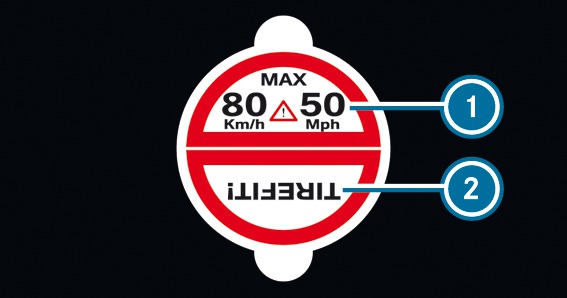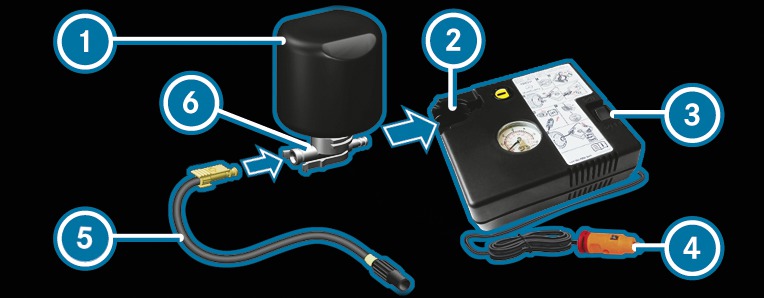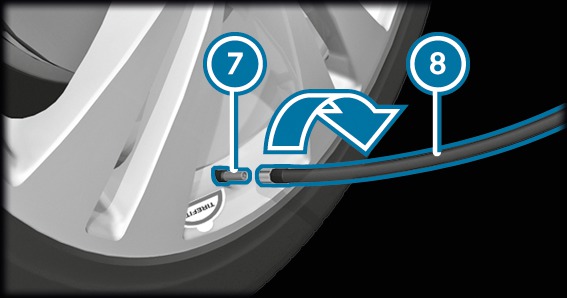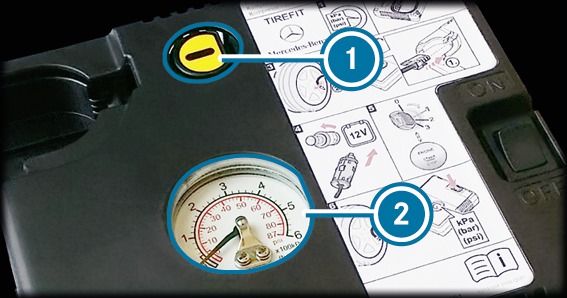Tyre sealant bottle and tyre inflation compressor More.
TIREFIT sticker
Gloves (depending on the vehicle equipment)
You can use TIREFIT tyre sealant to seal perforation damage of up to 4 mm, particularly those in the tyre contact surface. You can use TIREFIT in outside temperatures down to -20 °C.
The tyre sealant may be unable to seal the tyre properly, especially in the following cases:
there are cuts or punctures in the tyre larger than damage previously mentioned.
the wheel rim is damaged.
you have driven at very low tyre pressures or on a flat tyre.
Tyre sealant is hazardous to health and causes irritation. Do not allow it to come into contact with your skin, eyes or clothing, and do not swallow it. Do not inhale any vapours. Keep the tyre sealant away from children.
Observe the following if you come into contact with the tyre sealant:
Comply with the manufacturer's safety notes on the sticker on the tyre inflation compressor.
Have the tyre sealant bottle replaced in a qualified specialist workshop every five years.

 of the TIREFIT sticker to the instrument cluster within the driver's field of vision.
of the TIREFIT sticker to the instrument cluster within the driver's field of vision.  of the TIREFIT sticker near the valve on the wheel with the defective tyre.
of the TIREFIT sticker near the valve on the wheel with the defective tyre. 
 with the cable and hose
with the cable and hose  out of the tyre inflation compressor housing.
out of the tyre inflation compressor housing.  into flange
into flange  of tyre sealant bottle
of tyre sealant bottle  until the plug engages.
until the plug engages.  head downwards into recess
head downwards into recess  of the tyre inflation compressor.
of the tyre inflation compressor. 
 on the faulty tyre.
on the faulty tyre.  onto valve
onto valve  .
. 
 into a 12 V socket in your vehicle.
into a 12 V socket in your vehicle.  .
. The tyre is inflated. First, tyre sealant is pumped into the tyre. The pressure may briefly rise to approximately 500 kPa (5 bar/73 psi).
Do not switch off the tyre inflation compressor during this phase!
The tyre should then have attained a tyre pressure of at least 200 kPa (2.0 bar/29 psi).
If tyre sealant leaks out, make sure you clean the affected area as quickly as possible. It is preferable to use clean water.
If you get tyre sealant on your clothing, have it cleaned as soon as possible with perchloroethylene.
Please note that tyre sealant may leak out when unscrewing the filling hose.
After a maximum of ten minutes the tyre pressure must be at least 200 kPa (2.0 bar/29 psi).
If the minimum tyre pressure is not reached after the specified time, the tyre is too badly damaged. The tyre sealant cannot repair the tyre in this instance.
The braking and driving characteristics may be greatly impaired.
A tyre temporarily sealed with tyre sealant impairs the handling characteristics and is not suitable for higher speeds.
After use, excess tyre sealant may leak out from the filling hose.
Tyre sealant contains pollutants.
The tyre pressure must now be at least 130 kPa (1.3 bar/19 psi).
If the specified tyre pressure is not reached, the tyre is too badly damaged. The tyre sealant cannot repair the tyre in this instance.
The braking and driving characteristics may be greatly impaired.
Countries that have Mercedes-Benz Service24h: you will find a sticker with the telephone number, e.g. on the B‑pillar on the driver's side.

 next to manometer
next to manometer  .
. The filling hose stays on the tyre sealant bottle.

